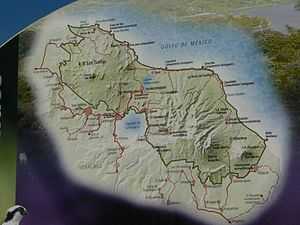Los Tuxtlas

The Los Tuxtlas region, very broadly, occupies parts of south central Veracruz, in east central Mexico. The region includes the Tuxtla Mountains and stretches from Laguna Alvarado, along the Gulf of Mexico, to Laguna del Ostión, then along the westernmost tributaries of Laguna del Ostión, to the northernmost tributaries of Río Coatzacoalcos, then along the Río San Juan to its merger with Río Papaloapan flowing into the Gulf of Mexico.
Geographically, the Tuxtla Mountains is the volcanic massif centered on Catemaco, bordering on the Gulf of Mexico and encompassing the gulf coast and inland terrain of the volcanic massifs of San Martín Tuxtla, Santa Marta and San Martín Pajapan from the Gulf of Mexico and roughly 100 meters inland to app. 1750 meters above sea level, including parts or all of the 9 counties (municipios) of Ángel R. Cabada, Santiago Tuxtla, San Andrés Tuxtla, Catemaco, San Pedro Soteapan, Tatahuicapan de Juárez, Mecayapan, Pajapan and Hueyapan de Ocampo.
The Biósfera Los Tuxtlas occupies mostly the coastal and higher elevations of the Tuxtla Mountains, including parts of all the above counties except Hueyapan de Ocampo.
The three counties of Santiago Tuxtla, San Andrés Tuxtla and Catemaco, which share common history, traditions and vicinity of Volcano San Martín Tuxtla, usually refer to themselves as Los Tuxtlas and ignore the rest of the area.
When Los Tuxtlas is referred to as the Olmec homeland, Los Tuxtlas includes all of the above plus parts of western Tabasco state.
To confuse the issues even more - the northernmost parts of Los Tuxtlas become part of the Llanura de Sotavento. The southern parts are known as Sierra de Soteapan, or the Sierra de Santa Marta with a subregion known as the Serranía de Bastonal.
Most of the Tuxtlas are considered part of the Papaloapan river basin, the southernmost section is part of the Río Coatzacoalcos river basin, and to keep geographers on their toes, that southern part also becomes part of the Tehuantepec Isthmus.
Politically, the area is a hodgepodge of political districts and has no cohesive representation. The 2005 electoral redistricting threw in some more municipalities into the Tuxtlas region. There is now a new political gambit splitting the area into microregions, Los Tuxtlas and Las Olmecas. It's an effort to ammeliorate poverty, but throws Los Tuxtlas together with several new municipalities.